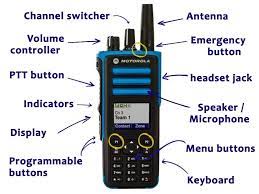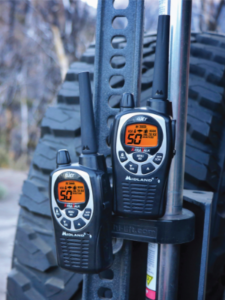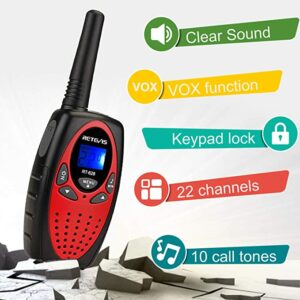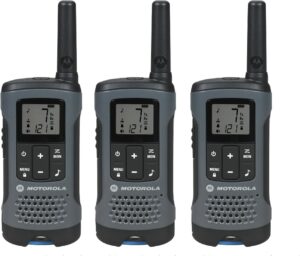Walkie talkies are simple to use and are an affordable way to stay in touch, whether you’re hiking in the wilderness or coordinating a team of workers on a job site. But how do they work?
What are Walkie Talkies?
A walkie talkie is a two-way radio, which differs from a standard radio in that it can both send and receive information. Using the same channel for both functions however means only one person can talk at any given time.
Walkie talkie were first developed in the 1930s by Canadian inventor Donald Higgs and American Alfred Gross, independently from one another. These devices allowed for people to communicate while also being mobile, which differentiated them from telephones of the time, and earned them the name walkie talkies.
Walkie talkies are hand-held, portable radios that transmit and receive radio signals over a shared frequency band. They are typically used in pairs, with each user having a transceiver (a transmitter and receiver in one unit) tuned to the same frequency. This allows users to communicate with each other without the need for a central base station.

Walkie talkies usually have a range of around 2 miles (3 km), but the exact range will vary depending on factors like terrain, weather, and interference from other radio signals.
How to use Walkie Talkies?
Before using a walkie talkie, people must make sure that their devices are on the same channel. In order to do this, ensure that your handset is set to receive and your microphone-cum-loudspeaker is switched to loudspeaker mode. If no one is talking, it’s likely that the device will be broadcasting.
By depressing the push-to-talk button, the loudspeaker switches to microphone function, which then broadcasts their words as radio waves across a pre-arranged channel.
The speaker says ‘over’ to indicate they have finished speaking, then releases the push-to-talk button so the handset can return to listening mode.
A walkie talkie is a two-way radio, meaning it can both send and receive information. Because the same channel is used for both functions, only one person can talk at any given time.
What people do use Walkie Talkie for now?
There are many different reasons why people use walkie talkies now. People use them for work, while others use them for recreation. Several uses for walkie talkies include:
- Keeping in touch with friends and family while hiking or camping
- Staying in communication with co-workers during events or projects
- Sending messages between vehicles when traveling in a convoy
- Using as a two-way radio for security or surveillance
- Having as a backup communication device in case of an emergency
- Kids are using them as toys to play pretend games
With so many different uses, it is no wonder that walkie talkies are still popular today. No matter what your needs are, there is likely a walkie talkie that can help you stay in touch and connected.
Midland 50 Channel Waterproof Long Range Walkie Talkie: Best Overall

The GXT1000VP4 GMRS walkie talkie is an excellent, dependable choice for your radio communication needs. With X-TRA TALK Power – the maximum allowed by law with Xtreme Range Technology – and Midland’s signature NOAA Weather Scan + Alert Technology, this radio will auto scan to alert you of severe weather updates. Whether you are camping, hiking, or overlanding, the GXT1000VP4 keeps you in touch with friends and family.
Retevis RT628 Walkie Talkies for Kids,Toys for 5-13 Year Old Boys Girls: Best for kids

The compact and lightweight body make this device easy to carry, as well as more comfortable to use with rounded corners that reduces the risk of scratches. The beautiful and strong plastic allow for a long-lasting toy. The VOX function enables children to speak directly to their neighbors without pressing the PTT button;you can also connect headphones to the device (not included).
The key lock feature on this TV works by allowing children to stay on the same channel while playing, preventing them from accidentally changing the channel.
Motorola T200TP Talkabout Radio, 3 Pack: Best for the trio

The T200TP is the portable radio you need to keep in touch with your friends and family. With a range of up 20 miles, this compact and lightweight radio can easily be taken on long walks, camping trips, or even shopping excursions around town. Plus, its durable design means that it can withstand being dropped inadvertently. And with 22 channels and 121 privacy codes available, you’ll always have plenty of options for staying connected while on the go.
Tips on how to communicate with different brands of Walkie Talkies
Sometimes, people with different brands of walkie-talkies wonder whether they can get them to work together. However, by following these tips, you’ll be able to make any two brands communicate.
1. Check the Chanel
You can also check if your radios are on the same frequency by looking at the number in the display. The number should be the same on both radios if they’re tuned to the same channel. If you’re still having trouble communicating with other brands of walkie-talkies, there’s a chance that one of your units is not working properly. Try testing it out with another radio to see if the issue is with the device or the compatibility between brands.Now that you know how walkie talkies work, you can stay connected even when you’re on the go! Just remember to follow these simple tips for making sure your radios can communicate with each other, no matter what brand they are.
2. Unblock CCTCSS blocking
If you are experiencing difficulties with communicating through your walkie-talkies, it may be due to CCTCSS (Continuous Tone Coded Squelch System) blocking. When this feature is activated, it sends a tone along with your voice. This cannot be detected by humans, but radios can pick up on the frequency. If the radio receiving the transmission does not have the same tone setting, then the message will not go through– explaining why some messages aren’t received from other brands of devices. The easy solution is to simply switch off CCTCSS functions on all participating walkie-talki
3. Turn DCS codes off
Another type of signaling is DCS, or Digital Coded Squelch. Instead of sending a tone like with CCTCSS, it sends a digital code. If your radios still won’t communicate with one another, they may have incompatible DCS codes. Simply turn the DCS feature off and they should start working together.
Final Thoughts
With advances in technology, some walkie talkies now offer additional features like GPS tracking, weather alerts, and even two-way messaging. But at their core, walkie talkies are still simple radios that let you stay connected when you’re on the go.
